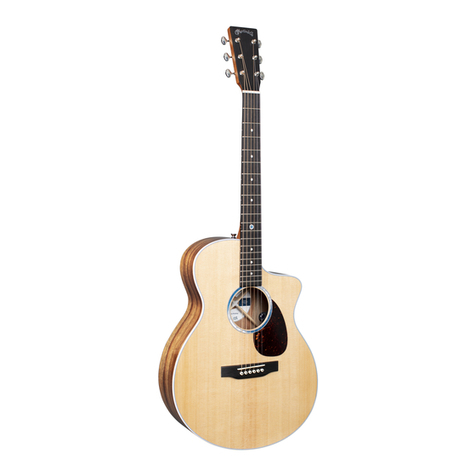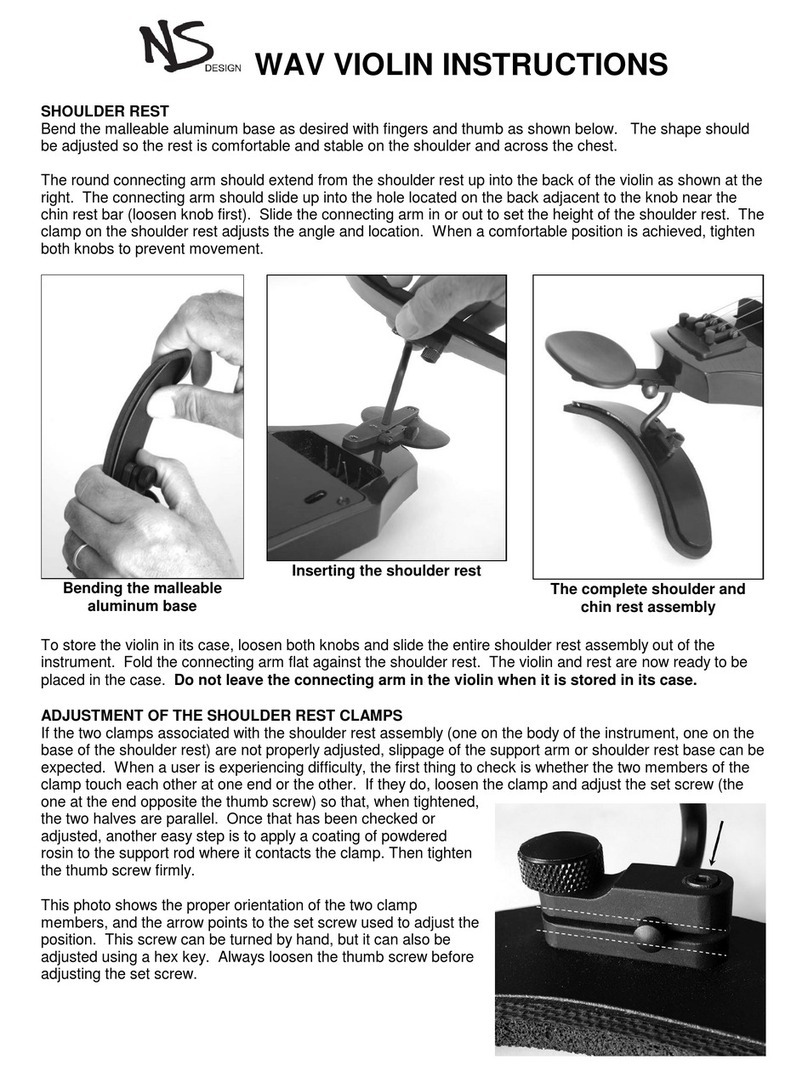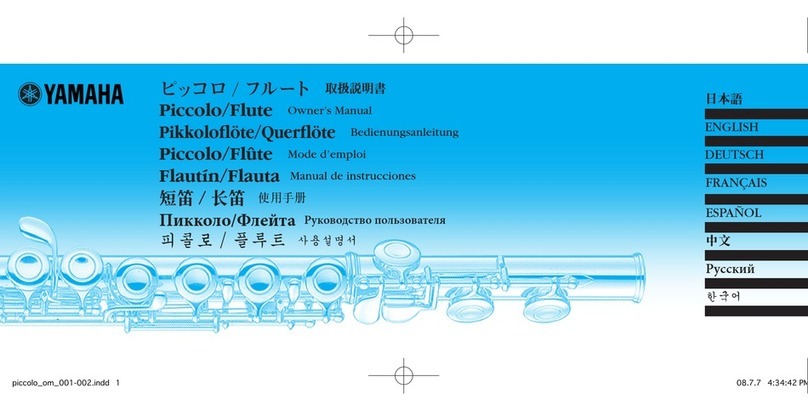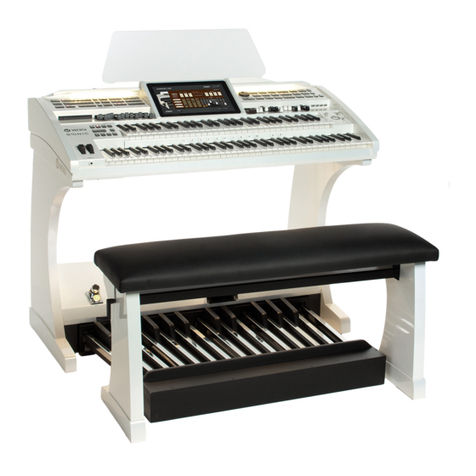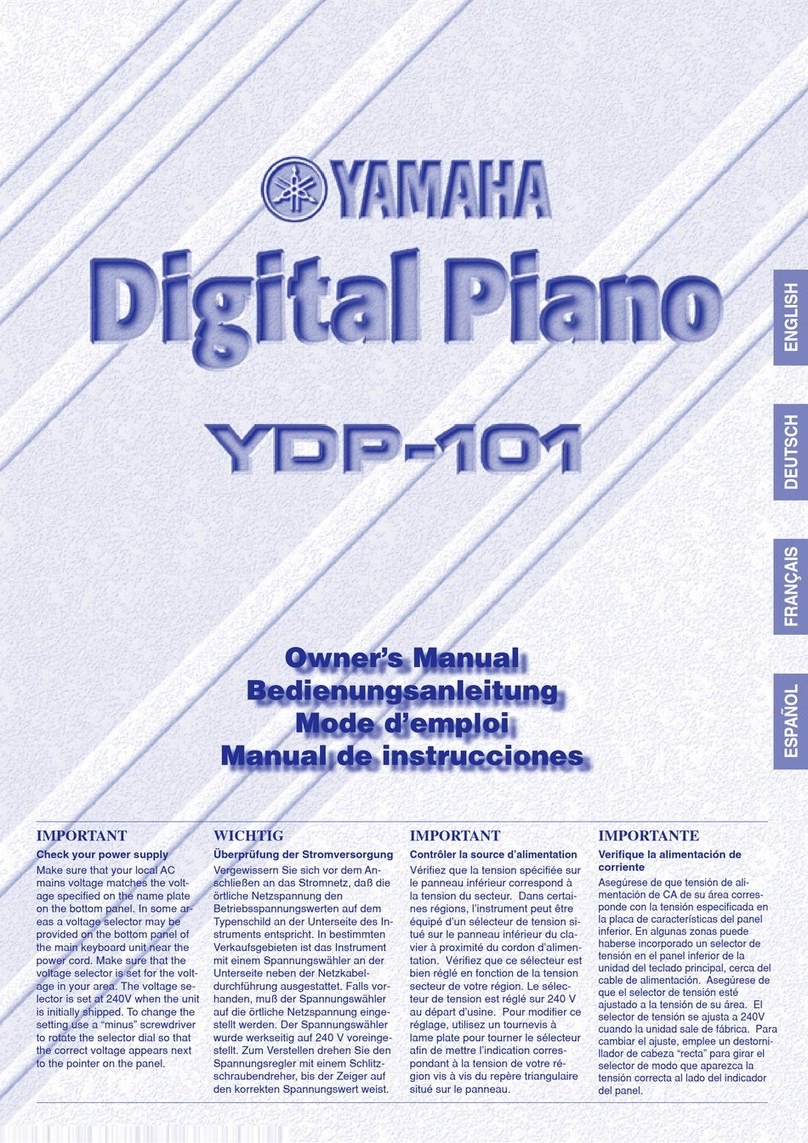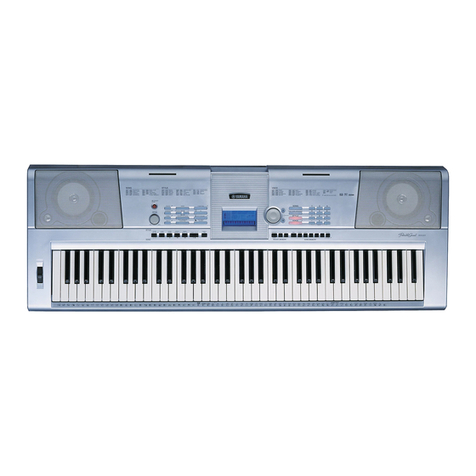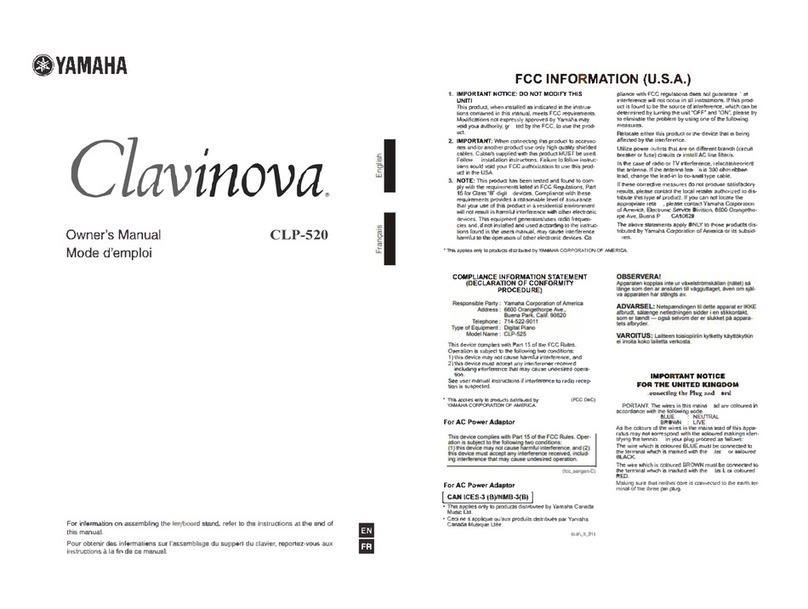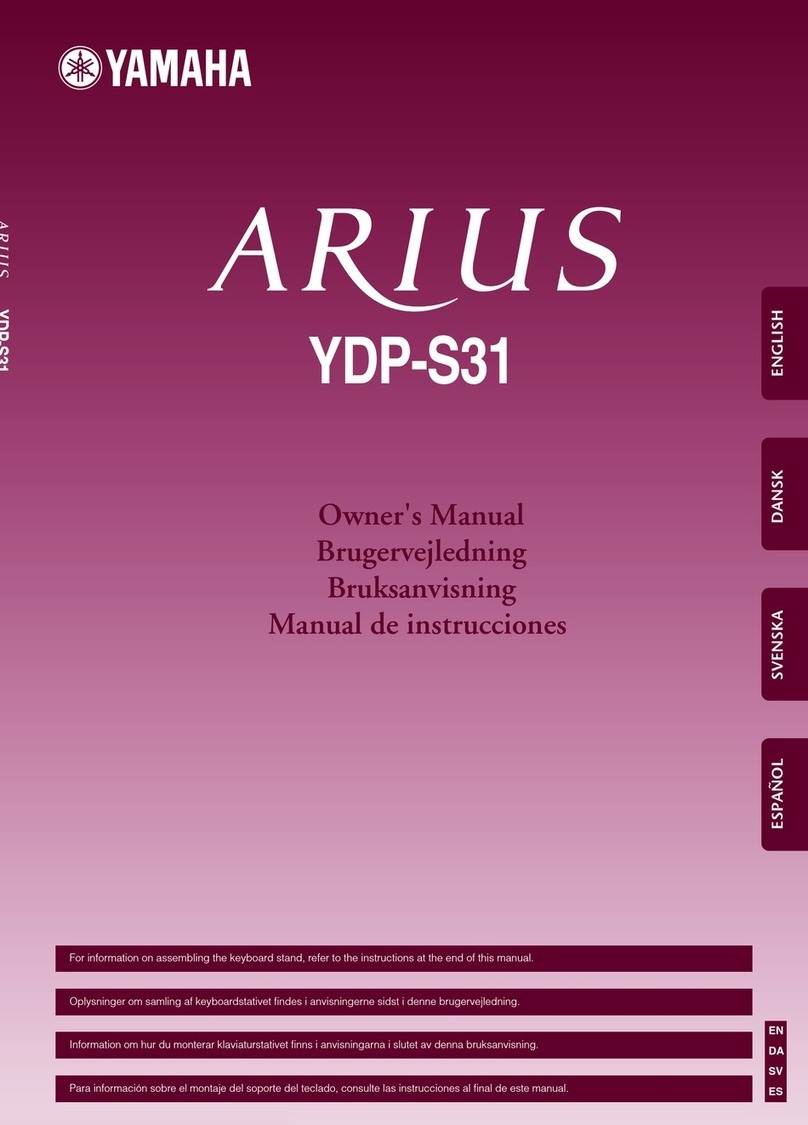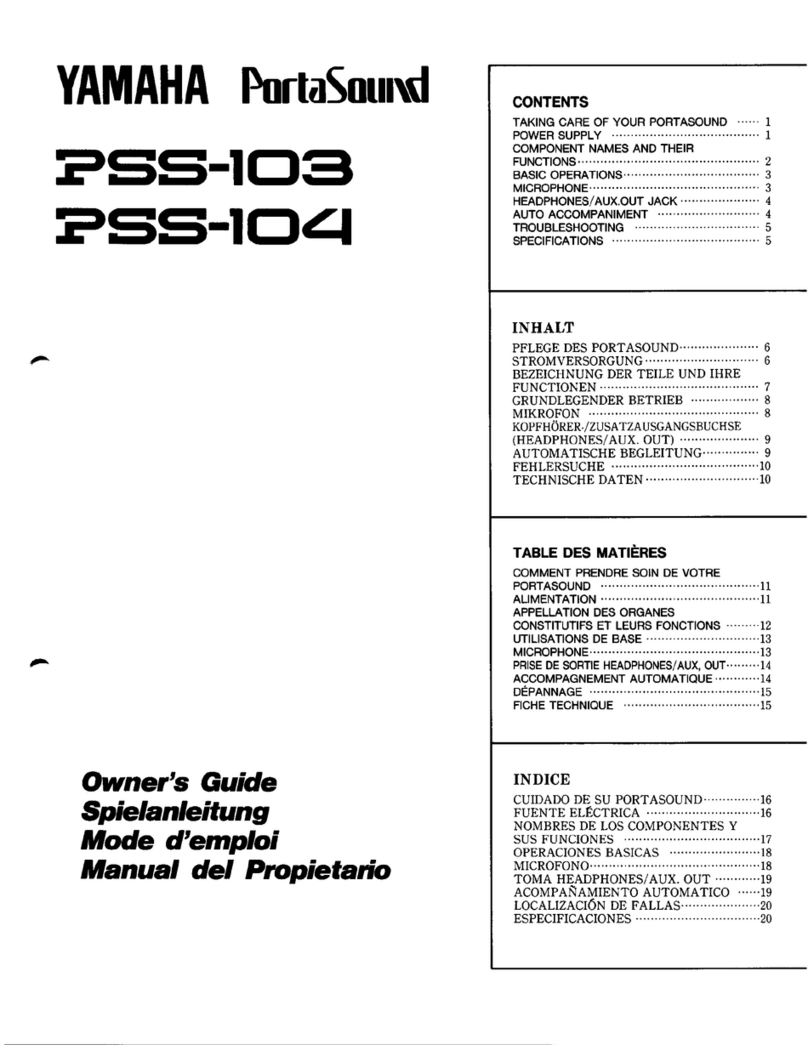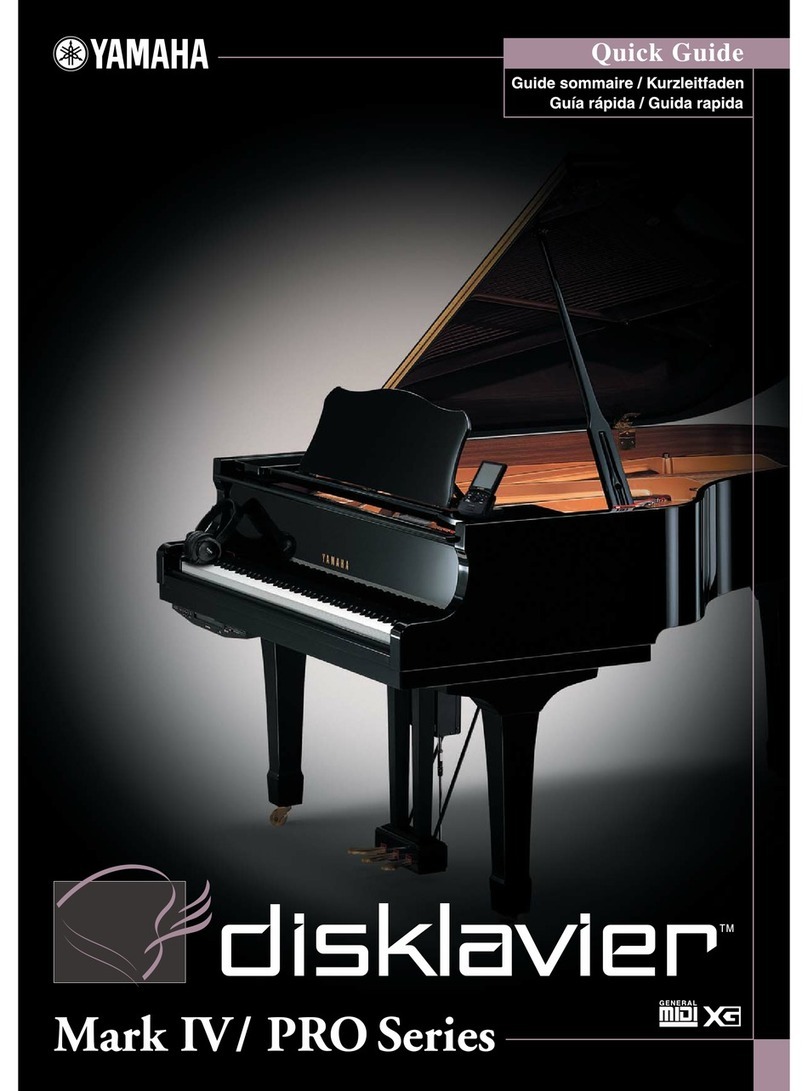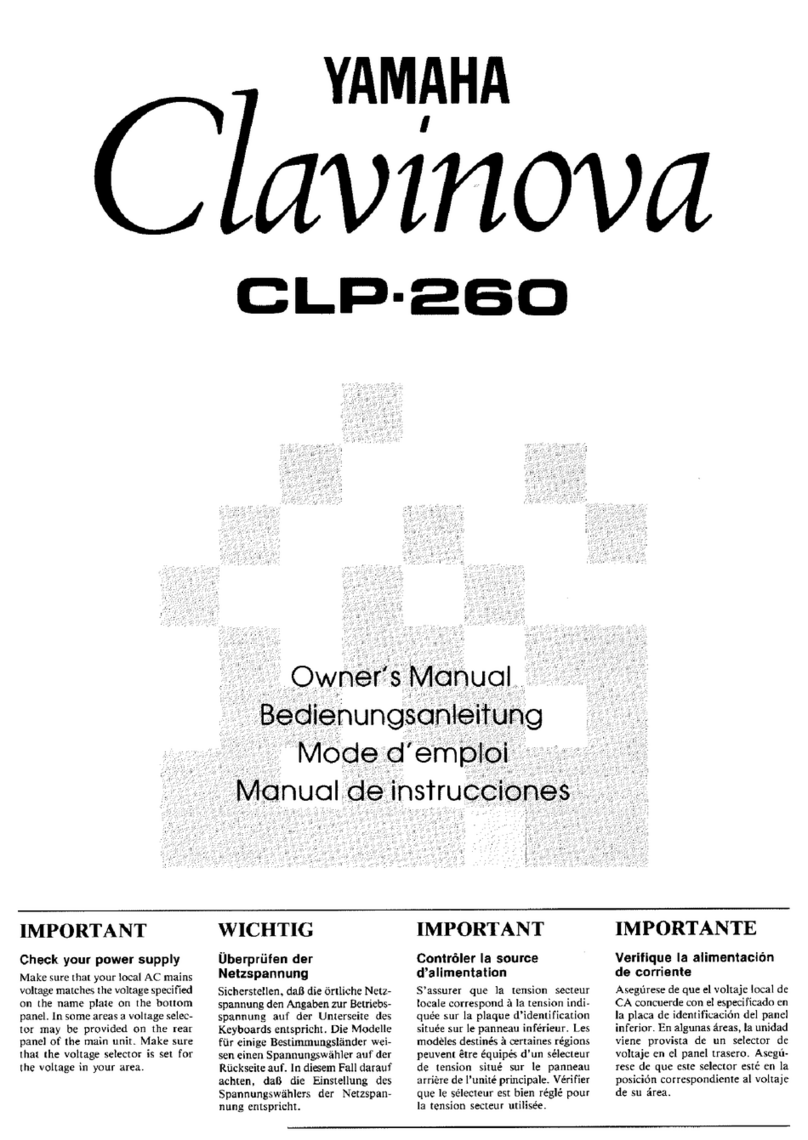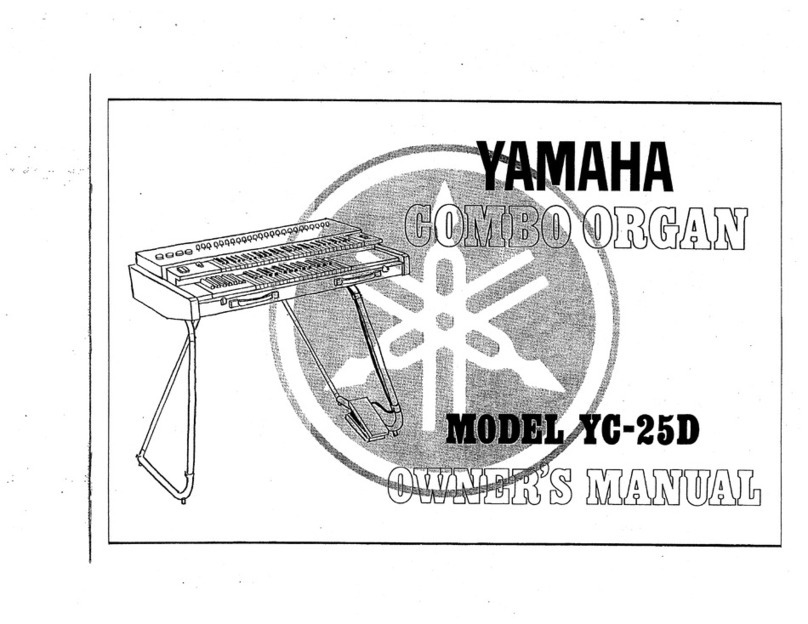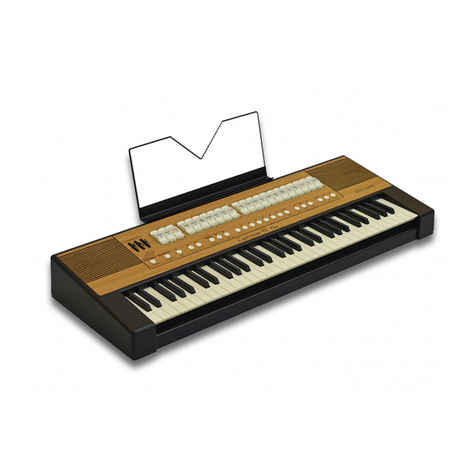Crumar Mojo Classic User manual

THE ULTIMATE
TONEWHEEL ORGAN
EXPERIENCE
USER'S MANUAL
Firmware version 1.00
www.Crumar.it
CRUMAR MOJO CLASSIC USER'S MANUAL - Page 1/20

Congratulations for purchasing your new Crumar Mojo. You made the right choice.
Crumar Mojo is a modern classic, is built around the most recent technologies but feels
and sounds as authentic as the real thing. e wish you years of enjoyment and good
music with your new digital tonewheel organ. Make sure you read through this useful
manual to explore its capabilities and, most importantly, have fun!
SAFETY INFORMATION
–Do not open the inst ument. The inst ument can be opened and epai ed only
by qualified pe sonnel. Unautho ized opening voids the wa anty.
–Do not expose the inst ument to ain o moistu e.
–Do not expose the inst ument to di ect sunlight.
–Be ca eful not to infilt ate powde s and liquids inside the inst ument. No on
the outside.
–If liquids get inside the unit, emove the powe immediately to p event the isk
of elect ic shock and contact a se vice cente as soon as possible.
–Do not clean using ab asive cleane s as they may damage the su faces.
–Please keep all packaging in case you need to t anspo t the inst ument to a
se vice cente .
–The inst ument can be used in any Count y that has a mains voltage between
100 Vac and 240 Vac.
CRUMAR MOJO CLASSIC USER'S MANUAL - Page 2/20

WARRANTY
–C uma Mojo is subject to 12 months manufactu e 's wa anty.
–Wa anty extensions a e at the disc etion of the etaile .
–Damages caused by misuse, imp ope maintenance o t anspo tation a e not
cove ed by this wa anty.
–Du ing the wa anty pe iod, the custome is entitled to epai o eplacement
of any pa ts conside ed defective at no cha ge.
–The possible eplacement of the enti e p oduct is at the manufactu e 's
disc etion.
CHAPTER SUMMARY:
1. The sound of Mojo p. 4
2. The Command Panel p. 6
3. The Rea Panel p. 10
4. Accessing the Edito p. 11
5. O gan Edit Pa amete s p. 14
6. Effect Edit Pa amete s p. 18
7. The USB Po ts p. 19
8. MIDI Map p. 19
9. Specifications p. 20
NOTES ABOUT THIS MANUAL
This manual can be conside ed a live document, as it may be updated in futu e
acco ding to possible changes int oduced in new fi mwa e updates. We ecommend
to keep an eye at the suppo t section of the C uma website and check fo new
ve sions of both the manual and the inst ument's fi mwa e.
You will find that some concepts might be epeated mo e than once, this happens
because the e could be a mention in a chapte , and a detailed explanation in a late
chapte .
We ecommend you to ead this manual with the inst ument in f ont of you, so you
can put into p actice what you a e eading and can have an instant feedback of the
notions he e explained.
CRUMAR MOJO CLASSIC USER'S MANUAL - Page 3/20

1. THE SOUN OF MOJO
VB3-II virtual tonewheel organ
The sound of C uma Mojo is based on the same “co e” of the vi tual
inst ument GSi VB3-II. While the vi tual inst ument uns on egula
compute s, Mojo is built on a new dedicated DSP platfo m,
pu posedly designed by C uma fo the new Mojo line. This means
that with Mojo not only you have access to a familia and intuitive
o gan inte face cont olling one of the most ealistic tonewheel o gan
simulations, but you also have access to a detailed and extensive pa amete set that
lets you customize the o gan sound in o de to match you p efe ences any way you
like.
Sound Engine main featu es:
•Full polyphony (61 uppe + 61 lowe + 25 pedals = 147 notes)
•91 modeled tonewheels with accu ate phase synch onization
•Adjustable leakage noise and c oss modulation between tonewheels
•A total of 22 diffe ent tonewheel gene ato s to choose f om
•Gene ato shaping fo a total of 154 gene ato combinations
•Adjustable global tuning f om 430 to 450 Hz
•Foldback on 16" deactivatable
•Complex wheels
•Resisto wi ing with multiple options
•Realistic “ un” moto wow & flutte
•Busba s and 9 key contact simulation
•St ing Bass with adjustable elease time
•Loudness " obbing" effect
•Single t igge ed pe cussion with natu al capacito discha ge/ echa ge
•Adjustable Pe cussion Level & Decay
•Vib ato/Cho us vi tual scanne
•Adjustable Vib ato Scanne depth & mix
•Dynamic tube ove d ive simulation
•Digital ste eo eve b
•Rota y speake simulation with vi tual mic ophone positioning, tube ove d ive,
tube feedback
•Roto s "F ont Stop" b ake position with adjustable p efe ed position
•Uppe and Lowe manuals SPLIT with adjustable split point
•Suppo ts pedal sustain
CRUMAR MOJO CLASSIC USER'S MANUAL - Page 4/20

Ha dwa e main featu es
•Dual Manual O gan with two 61-note 5 octave C - C wate fall semi-weighted
velocity sensitive keyboa ds
•Exte nal optional Wi-Fi antenna fo accessing the edito Web-App
•Online USB wi ed edito
•Two G oups of 9 Real D awba s plus 2 pedalboa d d awba s
•Knobs fo Volume, D ive, Reve b, Keyclick, C osstalk, Pe cussion Volume,
Balance, Distance, Bass, Middle, T eble
•Fou dedicated buttons fo Tonewheel o gan pe cussion.
•Dedicated buttons fo Vib ato on/off
•Vib ato type knob
•D awba HOLD mode fo alte nate d awba settings
•Two d awba p esets pe manual with easy sto age mode
•Dedicated button fo ota y effect speeds
•Pedal to lowe function (adds the sound of pedalboa d to lowe manual)
•Shift button fo alte nate functions (t anspose, ota y bypass)
•MIDI IN and OUT connections
•USB Type B (device) fo MIDI IN/OUT
•2 USB Type A (host) fo softwa e updates and wifi module
•Balanced Audio outputs
•Headphone jack
•Exp ession pedal input
•Sustain pedal input
•Halfmoon o Footswitch input with dedicated selecto
•AC in 100-240V
CRUMAR MOJO CLASSIC USER'S MANUAL - Page 5/20

2. THE COMMAN PANEL
In this chapte we explo e the command panel of the Mojo. Most of the cont ols on
the panel a e familia to vete ans of the tonewheel o gans. If you fit that catego y,
you've p obably al eady ecognized the d awba s, uppe on the left, lowe on the
ight, pedalboa d in the middle; then the cont ols fo the “Vib ato Scanne ”, the fou
tablet switches fo the pe cussion, and you've also noticed that eve ything is ight
whe e it belongs.
2.1 – LEFT SI E KNOBS
On the left side you find the 3 knobs: volume ove d ive and eve b. Having these
th ee on the left side is kind of tactical, so you can keep playing with you ight hand
while adjusting the th ee most impo tant pa amete s befo e sta ting you
pe fo mance.
2.2 - VIBRATO/CHORUS
The Vib ato/Cho us cont ols, which belong to this side of the console, a e p esented
exactly like on a vintage tonewheel o gan. The e a e two la ge buttons fo tu ning
the effect on o off on the uppe o on the lowe manual independently, and a la ge
knob that lets you choose the type of effect to use between the 6 possible
combinations: V1, C1, V2, C2, V3, C3 whe eas the 'V' p oduce just a vib ato effect and
the 'C' p oduce a cho us effect. In the Mojo the selecto is a ota y encode with 6
LEDs that indicate the cu ent selection.
PLEASE NOTE: As opposed to mechanical “rocket” switches, these are push-push yellow
illuminated buttons, about the size of the vintage tablet switches, that work exactly the
same way. You can hit them in any point to activate them, no need to reach for the exact
middle point. Furthermore, when the C/V effect is turned on for the lower manual, it's also
applied to the pedalboard tones.
CRUMAR MOJO CLASSIC USER'S MANUAL - Page 6/20

2.3 – ROTARY SPEE BUTTON
The la ge ho izontal button labeled ROTARY SPEED is used to cont ol the built-in
Rota y Speake simulato . When the simulato is on, push this button to switch
between the slow and the fast speeds; push and hold fo about half a second fo
b aking the ota y speake (stop position). When in b ake, push again to etu n to the
p evious speed. The light will blink smoothly slow o fast, o will emain still, to
indicate the cu ent speed.
Use this button in conjunction with the SHIFT button fo enabling/disabling the
Rota y Speake simulation (see below).
PLEASE NOTE: if this button seems unresponsive, check the HM/FS selector on the back
of the instrument. In order to use this button, the selector must be in the FS (FootSwitch)
position. This button cannot be used if an Half-Moon switch is in use. Connections are
explained later in this manual.
2.4 – THE SHIFT BUTTON
The small SHIFT button on the top left side of the cont ol panel is used fo a few
alte nate functions:
1. Push and hold the SHIFT button along with the ROTARY SPEED button to
disable o enable the inte nal Rota y Speake simulation. If the simulation is
OFF, the ed LED next to the ROTARY SPEED button becomes lit.
2. Push and hold the SHIFT button along with the MANUAL button of the lowe
section, next to the PEDAL TO LOWER indication, to activate o deactivate the
pedal-to-lowe function that b ings the pedalboa d tones to the lowe manual.
If this function is active, the ed LED will become lit;
3. Push and hold the SHIFT button along with notes, on the uppe manual, f om
the second C note to the fou th C note to activate the t ansposition. If a
t ansposition is active, the ed LED next to the SHIFT button will become lit. To
cancel the t ansposition, hold SHIFT and play the thi d C note (middle C).
PLEASE NOTE: when the transposition is active, certain notes that are outside the 61-
note playable range will not be available any more. For example, since the last note is C, if
the transposition is up by one semitone, C becomes B, so the C key will become silent.
CRUMAR MOJO CLASSIC USER'S MANUAL - Page 7/20

2.5 – UPPER PRESET
C uma Mojo offe s two p esets fo each manual, plus the CANCEL position, the
HOLD function, and of cou se the manual d awba mode.
PLEASE NOTE: Presets will only store the drawbar position, and nothing else. Also, when
a preset is active, the percussion is turned off on the upper manual. This behavior reflects
exactly what happens on the real tonewheel organs, with just a few changes.
–To select a p eset, just push the desi ed button A o B;
–To use the live d awba s, push the MANUAL button;
–To sto e a p eset: once you've set the d awba s to the position you wish to
sto e, push and hold one of the two p eset buttons, A o B, fo about 2 seconds
until the light goes off and on again.
The HOL mode will let you p epa e an alte nate d awba egist ation while holding
the cu ent egist ation active. When the MANUAL button is active, p ess the
MANUAL button again, it will sta t blinking. While it's blinking, move the d awba s to
p epa e you alte nate egist ation, you'll notice that the sound will not eflect the
changes you' e applying to the d awba egist ation. Once done, p ess the MANUAL
button again to apply the change. The light will stop blinking.
The CANCEL mode will tu n the whole manual off while enabling the note
t ansmission on the MIDI output po ts. To enable the CANCEL mode, push and hold
the MANUAL button until the light goes off. To esume f om the CANCEL mode, push
the MANUAL button o one of the A o B p eset buttons.
2.6 – LOWER PRESETS
Lowe p esets wo k exactly like fo the uppe section, with the only exception that
you have no pe cussion on the lowe manual, so selecting a p eset will not tu n the
pe cussion off.
CRUMAR MOJO CLASSIC USER'S MANUAL - Page 8/20

2.7 – RIGHT SI E KNOBS
On the top ow we have:
–CLICK: use this knob to adjust the amount of keyclick noise, which is the typical
noise you hea at the attack of each note, that on a eal tonewheel o gan is
caused by elect ical contacts unde neath the keyboa d;
–XTALK: use this knob to adjust the amount of cross-talk effect. Also this is an
effect found in the o iginal tonewheel o gan, mostly caused by the la ge
amount of wi ings that inte connect all the pa ts of the elect onic ci cuit;
–PERC. VOL: this comes handy to adjust the volume of the pe cussion sound in
case it becomes too loud o too soft, which is a condition that may va y
acco ding to the type of amplification being used. Sometimes the pe cussion is
just ight, but its pe ception may change when the speake s a e set to a
diffe ent position, o when just using a diffe ent set of speake s;
–BALANCE: when the inte nal Rota y Speake simulation is active, this knob
adjusts the balance between the uppe ho n and the bass oto ;
–ISTANCE: when the inte nal Rota y Speake simulation is active, this knob
adjusts the distance between the vi tual speake s and the vi tual mic ophones,
va ying the amount of pe ception of the Dopple effect and othe acoustic
phenomenons that happen in a ota y speake .
The knobs on the bottom ow a e BASS, MIDDLE and TREBLE. Nothing but an
efficient and handy 3-band equalize useful to balance the sound acco ding to the
type of amplification system used, its positioning in the venue, also the kind of
venue, possible esonances o unwanted eve be ations. When all th ee knobs a e in
the middle position, the sound can be conside ed “flat”, i.e. with no f equencies
added to o subt acted f om the o iginal sound.
2.8 - PERCUSSION
Like on the the vintage tonewheel o gans, the command panel featu es the fou
pe cussion switches that have the following functions, f om left to ight:
1. Tu n the pe cussion on o off.
2. Select between soft o no mal pe cussion volume.
3. Select between fast o slow decay.
4. Select the ha monic applied to the pe cussion tone.
PLEASE NOTE: the percussion is only present at the upper manual. Also, when the
percussion is active, the 1' drawbar will be muted.
CRUMAR MOJO CLASSIC USER'S MANUAL - Page 9/20

3. THE REAR PANEL
All the connections a e p esent at the back panel. F om left to ight:
–HEA PHONES: plug you headphones he e to p actice without an exte nal
speake . This output is pa alleled with the ste eo line output.
–AU IO L & R: these a e TRS jacks ca ying balanced line outputs at a +4 dB
level, but can also accept TS (mono) jacks fo unbalanced signal. If you have to
use long cables, we suggest to use all balanced connections.
–SWELL: this TSR Jack input accepts an exp ession pedal with linea
potentiomete in the ange 10 ~ 50 Kohm; we suggest to use the o iginal
C uma exp ession pedals, but othe pedals f om othe manufactu e s may be
compatible.
–SUSTAIN: if you have a sustain pedal like those used fo digital pianos, you can
connect it he e fo cont olling the Rota y Speake speeds (see configu ation in
the Edito chapte ) o fo sustaining notes.
–HALFMOON or FOOTSWITCH: This section includes a TRS Jack input and a 2-
way selecto . You can connect eithe a Crumar Dual Footswitch o a Crumar
Halfmoon (optional accesso ies) fo cont olling the Rota y Speake speeds.
–MI I IN – OUT: use these po ts to connect to othe MIDI equipment using
standa d MIDI cables.
–USB MI I I/O: use this USB “device” po t to connect the inst ument to you
compute o mobile device fo accessing the Edito o fo DAW integ ation. This
po t ca ies only MIDI signals.
–SYSTEM USB: these a e two USB “host” po ts that can accept the USB Thumb
d ive fo installing futu e fi mwa e updates, o fo connecting the optional
(included) Wi-Fi Dongle, o even fo MIDI-USB cont olle s such as the C uma
MojoPedals 2018 pedalboa d, as explained late in this manual.
–The last two a e the Powe button and the AC plug.
PLEASE NOTE: hen the HM/FS Selector is in HM position (for Half-Moon switch), the
Rotary Speed button on the top panel is unresponsive. Set this to FS for using an external
Footswitch and/or the integrated button. This also applies to the sustain pedal functions.
CRUMAR MOJO CLASSIC USER'S MANUAL - Page 10/20

4. ACCESSING THE E ITOR
Since the C uma Mojo is based on GSi VB3-II, the e's a load of pa amete s that can
be adjusted to obtain the desi ed o gan sound. These pa amete s a e accessible
th ough the Edito softwa e.
Mojo offe s two edito s:
1. The inte nal edito , accessible th ough a Wi-Fi connection. The Mojo will
function as an hot-spot that c eates its own p ivate netwo k to connnect to.
2. The emote MIDI edito , accessible th ough the MIDI-USB po t and a compute
o mobile device connected to the Inte net.
4.1 - OPTION # 1 – Wi-Fi Editor
Mojo comes with an optional USB Wi-Fi dongle. Connect
it to one of the two SYSTEM USB po ts when the Mojo is
turned off, then tu n on the inst ument and wait until it's
eady. Use you compute o you mobile device and scan
fo new Wi-Fi netwo ks. You should be able to find a SSID
like “Mojo-xxxxxx”, accessible without passwo d. Access
this netwo k, and if you mobile wa ns you that the e's no
inte net available with this netwo k (which is quite
obvious), dismiss the wa ning and continue.
Now you can launch you favo ite web b owse and navigate to the following URL:
http://192.168.1.1/
PLEASE NOTE: the internal i-Fi access point accepts only one connection at a time, so if
you can't get to connect to the Mojo, check that you haven't left another device
connected. Also, if you don't want someone else to connect to your Mojo, just make sure
the dongle is not present before you turn on the instrument.
4.2 – OPTION # 2 – MI I Editor
You need a USB cable (like those used fo connecting a p inte to a compute ), use it
to connect the Mojo to a compute , o to an And oid device using an OTG adapte , o
to an iPad using Apple's Came a Connection Kit. Once done, launch you CHROME
b owse and navigate to this website:
https://www.gsidsp.com/mojoclassic
PLEASE NOTE: if you don't have CHROME, install it from Google, or from the Play Store
(Android) or from the App Store (Apple). Other browsers may not be compatible.
CRUMAR MOJO CLASSIC USER'S MANUAL - Page 11/20

4.3 – E ITOR HOME PAGE
When the connection is done and the Edito loads
into you web b owse , you should be able to see
the main sc een, like the pictu e he e.
On the top ba you can see an HOME icon. Tap he e
eve y time you need to etu n to this sc een (don't
use the BACK function of you b owse ). On the top
ight the e a e two mo e icons: one is fo
saving/loading snapshots, the othe is fo viewing
an help page.
The bottom ba contains links to othe pages.
In the middle of the sc een you have the Global
Options:
–Tuning; This is the global tuning, whe e the
efe ence A note can be set to a f equency
between 430 and 450 Hz. The default value is
440 Hz.
–TX Channel: select the MIDI Basic Channel fo t ansmitting events to the MIDI
output po t.
–TX Velocity: set this to YES if you want the velocity info mation is always
t ansmitted. If this is set to NO, velocity info mation is fixed at 127 and the “high
t igge point” is used fo both keyboa ds. High t igge point is always used fo
the inte nal sound gene ato .
–CC Send: choose whethe you wish to send all MIDI Continuous Controller
messages, only messages elated to the pedals, o none.
–CC Presets: choose whethe you wish to send all d awba MIDI CC messages
when an o gan p eset is selected. If this is on Send, CC messages will be sent
each time you switch to a diffe ent p eset, fo both manuals.
–Sustain Pedal: select the function to be assigned to the inte nal SUSTAIN
connecto :
–Rotary Speed (Latch): use the sustain pedal to switch between ota y speeds in latched
mode, i.e. the speed changes each time the pedal is pushed and eleased;
–Rotary Speed (Mom.): use the sustain pedal to switch between ota y speeds in
momenta y mode, i.e. hold the pedal down fo slow, elease fo fast;
–Sustai Upper, Lower, All: decide whethe to use the sustain pedal to sustain notes on
the uppe manual only, o on the lowe manual only, o on both manuals.
CRUMAR MOJO CLASSIC USER'S MANUAL - Page 12/20

4.4 - SNAPSHOTS
Mojo can save and ecall up to 8 snapshot. A
snapshot sto es the values of all editing
pa amete s, and can be used to sto e a pa ticula
setting that you might want to ecall o fo
alte nating between diffe ent settings. It's like
having diffe ent tonewheel o gans at you
disposal.
Tap the Snapshot icon on the top ight of the
edito sc een if you wish to save (the ed floppy
disk icon) o ecall (the g een folde icon) one of
the available shapshots. Eve ytime a snapshot is
ecalled, is set as the default snapshot and will
always be ecalled when the inst ument is tu ned
on.
4.5 – PARAMETER E ITING
Tap on the links on the bottom ba to open the pa amete pages fo the o gan pa t
and fo the effect section. Pa amete s a e p esented unde the fo m of la ge
ho izontal slide s with a eadout value. Sc oll slide s left o ight to va y the values.
Sc oll the page up o down to eveal the enti e content. Click the yellow title ba s to
collapse o expand a section.
CRUMAR MOJO CLASSIC USER'S MANUAL - Page 13/20

5. ORGAN E IT PARAMETERS
Pa amete s fo the o gan pa t:
–Generator: select a tonewheel gene ato f om this list. Each gene ato is based
on actual values as measu ed f om eal console o gans of the B/C/A se ies.
–Generator Shape: select between OFF (no shaping) o 3 levels of CUT and 3
levels of BOOST. These will modify the amplitude cha t of the gene ato values
acco ding to diffe ent positions along the gene ato . This pa amete does not
apply any equalization to the sound. Levels 1 can boost o cut sta ting f om
wheel n. 25; levels 2 sta t f om wheel n. 52; levels 3 sta t f om wheel n. 72.
–Leakage: adjusts the backg ound hum & hiss.
–Crosstalk: adjusts the amount of c osstalk caused by the analog ci cuit y. This
is a ve y impo tant element of the tonewheel o gan sound.
–Xtalk Shape: since the c osstalk consists of both bass and t eble tones, this
pa amete mixes between the p esence of one o the othe , left towa ds a
“ umble” noise, ight towa ds a “b illiant” noise.
–Complex wheels: a e special tonewheels only used fo the fi st 12 tones wi ed
with the pedalboa d. Unselecting this pa amete will use standa d sinus
tonewheels.
–Foldback on 16': the fi st 16 wheels wi ed to the keyboa ds a e usually folded
back, thus sta ting f om wheel n.13 athe than f om wheel n.1. If you wish to
use the fi st 12 wheels on the manuals, uncheck this option but you should also
uncheck the Complex wheels.
–Resistor wires: a e the small wi es that in the vintage o gan connect the
keyboa ds to the gene ato . This pa amete offe s th ee diffe ent values:
“Console: NEW”, as specified by the o iginal B3 specifications; “Console: OLD”,
esulting in a mo e p esent low-end; “Spinet”, same as “Console NEW” but
without the foldback.
–rawbar trims: the 9 pa amete s unde this section can be used to adjust the
p esence of each d awba . This will apply on top of the actual d awba
egist ations fo both the uppe and the lowe manual.
–Percussion settings: set the pa amete s of the pe cussion ci cuit such as the
level when it's on no mal o soft, the decay time when it's on slow o fast, the
ove all level, and the loudness loss when the volume tab is set to no mal.
CRUMAR MOJO CLASSIC USER'S MANUAL - Page 14/20

–Perc Paradise Mod: this is a “hack” that causes the pe cussion to neve decay.
What's special in this is that if you activate the scanne vib ato effect, you'll
notice that the vib ato is applied to the est of the d awba s but not to the
pe cussion tone.
–Other settings: he e you can adjust the depth of the vib ato ci cuit and the mix
amount that affects the cho us settings, plus some pa amete s elated to the
gene ation of the KeyClick noise.
–Preamp Bass / Treble: adjust the f equency esponse of the o gan's built-in
p eamp ci cuit y.
Pa amete s fo the Rota y Speake a e:
–Horn slow / fast: adjust the speed offset of the ho n fo when the speed is on
slow o on fast.
–Bass slow / fast: same as above but fo the bass oto .
–Horn up / down: adjust the accele ation and decele ation times of the ho n fo
the t ansitions between the slow and fast speeds. When the b ake is engaged,
the powe is taken off f om the moto so the ho n slows down until stopping
only d iven by the cent ifugal fo ce, so the time between fast and stop may be
longe than f om fast to slow.
–Bass up / down: same as above but fo the bass oto .
–Ambience: a eal amplifie stays in a eal envi onment causing the
mic ophones to captu e the sound eflections as well as the di ect sound
coming f om the speake s. This pa amete adjusts the amount of
envi onmental eflections.
–Cabinet: adjusts the amount of esonances caused by the wooden cabinet.
–Mic Angle: adjusts the angle between the two mic ophones at the ho n,
anging f om 0 (both mic ophones in the same spot) to 180 deg ees
(mic ophones at the opposite sides of the cabinets). This simulation conside s
only th ee mic ophones, two fo the ho n and one fo the bass oto .
–Horn EQ: not all vintage ota y speake s have the same quality fo what
conce ns the sound coming f om the ho n, some a e b ighte , some a e dulle
o maybe just well balanced. This pa amete lets you adjust the t eble esponse
of the ho n sound.
CRUMAR MOJO CLASSIC USER'S MANUAL - Page 15/20

–Mid reflections: adjusts the amount of sound eflections happening in the
middle of the ste eo field.
–oppler intensity: the so called “Dopple ” effect is the fundamental of the
“Leslie” effect that causes the sound to be cyclically untuned while the sound
sou ce (the speake ) gets fa the o nea e to the listened; this pa amete lets
you adjust the amount of this effect that is mostly caused by the sound
eflections ove the walls a ound the amplifie .
–ry Leak: some of the d y sound coming f om the speake s does not each the
otating elements and is mixed with the otating sound. Use this pa amete to
adjust the amount of d y signal you want to be mixed in.
–Bass Port: a eal Leslie cabinet has a hole in the back that se ves fo two
easons: 1) lets the heat f om the moto s ventilate out f om the cabinet and 2)
acts as a bass tuning po t, like those found on mode n speake s. If you put a
mic ophone in f ont of this hole you get nothing but sub-bass f equencies. Use
this pa amete to adjust the amount of sub-bass you want to get into the mix.
–Tube feedback. This is a ve y impo tant pa amete that wo ks on an aspect of
the whole amplification system that can d astically va y both the dynamic
esponse and the f equency esponse, as well as have an impact on the
ove d ive. When a Leslie cabinet is set ve y close to the Hammond o gan and is
played at a high volume, the e's some so t of feedback between the tubes, the
t ansfo me s and the pickups of the Hammond and the speake s of the Leslie,
esulting in a sound that tends to get “fatte ”, the attack is “punchie ” and the
disto tion is agg essive, giving you the feeling that some so t of ene gy is
looping between the o gan and its amplifie . Now, a genuine Leslie 122 o 147
is only 40W of powe , but if you t y to connect you Hammond o gan to a 100W
guita amp such as a Ma shall JCM900 o a Fende Twin you'll notice that the
amp sta ts going in feedback even if you don't play any note on the o gan. This
is... pu e analog powe ! T y this pa amete at small steps, it can d astically
change the sound in both a pleasant o unpleasant way, acco ding to you
tastes.
–Stop Position: you can use this pa amete to find a position whe e the ho n
and oto should “p efe ably” stop when you set the speed leve in the b ake
position and the “F ont Stop” option is enabled. Please conside that not always
the position you've set is eached with p ecision, it depends mostly on the
Ramp Down times you've set... afte all it's vi tual eality, baby! It takes into
account the kinetic ene gy, the g avity, the belt f iction...
–Noises: well, a eal ota y effect is fa f om being a quiet amplifie . You
mic ophones will pick up not only the sound but also the wind gene ated by
the otating elements, and the elays that switch between the fast and slow
moto s. Use this pa amete to adjust the amount of audible noises.
CRUMAR MOJO CLASSIC USER'S MANUAL - Page 16/20

–Memphis Style: check this pa amete to unplug the moto s that d ive the bass
oto . This way, the bass stays motionless while the ho ns keep spinning.
–Front Stop: this ve y sought afte function causes the ho n and the bass oto
to stop always in a “sweet” spot eve y time the b ake is engaged. VB3-II uses a
simple algo ithm that p oduces this effect in a ve y pleasant and seamless way
that you won't even notice when you' e b aking the oto s.
Notes on the rotation speeds.
All pa amete s in the edit pages, wheneve moved, display the eadout value in
eithe MIDI o actual value, when available. As fo the Rota y speake 's otation
speeds and times, values a e shown in Hz and Seconds. To conve t Hz to RPM
( evolutions pe minute), just multiply the Hz value by 60. Fo example, the ho n,
when the Ho n Slow pa amete is set at 64, otates at 0,77 Hz which t anslates in 46,2
RPM. All the speed values can be va ied between 50% and 150% of the cente value.
The amp up and amp down times a e in seconds, and can be va ied between 50%
and 500% of the cente value.
Cente values a e:
–Ho n slow: 0,77 Hz 46,2 RPM→
–Ho n fast: 6,9 Hz 414 RPM→
–Bass slow: 0,72 Hz 43,2 RPM→
–Bass fast: 6,4 Hz 384 RPM→
–Ho n amp up: 1 second
–Ho n amp down: 0,8 seconds
–Bass amp up: 6 seconds
–Bass amp down: 3,5 seconds
These times a e ave age values as measu ed by a wide sample of well wo king and
se viced vintage Leslie 122, 142, 147 and 145 models. Due to cent ifugal ene gy,
when the Roto s amp down f om fast to b ake and the F ont Stop option is disabled,
they take a bit longe to get to full stop position.
CRUMAR MOJO CLASSIC USER'S MANUAL - Page 17/20

6. EFFECT E IT PARAMETERS
Mojo featu es a built-in high quality ste eo digital eve b that can be adjusted in a
va iety of ways in o de to ep oduce vi tually any kind of a tificial envi onment.
Reve b settings a e:
–ecay: adjusts the ave age eve b tail length.
–amp: simulates va ious types of eflecting walls, f om tiles to abso be panels.
–iffusion: adjusts the diffusion of t aveling waves ac oss the eflecting
su faces.
–Pre-delay: adjusts the time between the di ect sound and the ea ly eflections.
–Room size: adjusts the size of the vi tual oom, f om a small cabinet to a la ge
tunnel.
–High / Low shelf: adjust the amount of t eble o bass f equencies to be to cut
off the sound befo e sta ting to eve be ate.
This space intentionally left blank.
CRUMAR MOJO CLASSIC USER'S MANUAL - Page 18/20

7. THE USB PORTS
Mojo includes 2 Type-A “host” USB 2.0 po ts. These a e mainly used fo
updating the softwa e, fo file functions o fo accepting exte nal MIDI
accesso ies. An inte esting use fo a USB system po t is the possibility to
connect a “Class-compliant USB-MIDI device”, i.e. one of the many MIDI devices
that don't need special d ive s when they a e connected to a conventional
compute . The Mojo will ecognize USB-MIDI devices and will use them along with any othe MIDI
equipment connected to eithe one o both the classic MIDI inputs located on the ea panel.
Please avoid connecting unsupported devices to this port. Please note that this port can supply a max of
250 mA of current. Do 't use this port to charge mobile devices.
O iginal CRUMAR accesso ies that can be connected to the SYSTEM USB po ts:
–Mojopedals 2018
–G.M.LAB D9U – d-i-y d awba cont olle
–G.M.LAB D9X – d-i-y d awba cont olle with extended featu es
–G.M.LAB MJU – d-i-y Midi Jack USB
An additional Type-B USB 2.0 po t is p esent at the back side of the Mojo that
p ovides Class-compliant USB-MIDI IN/OUT connection to you compute . Use this
po t to connect the Mojo to you compute softwa e. No d ive s a e needed fo
Windows, OS X and Linux.
8. MI I MAP
PARAMETER NAME C.C.
NUMBER
REMARKS PARAMETER NAME C.C.
NUMBER
REMARKS
D awba Uppe n.1 12 Volume 7
D awba Uppe n.2 13 D ive 76
D awba Uppe n.3 14 Reve b 91
D awba Uppe n.4 15 Key-click 75
D awba Uppe n.5 16 Bass 8
D awba Uppe n.6 17 Middle 9
D awba Uppe n.7 18 T eble 10
D awba Uppe n.8 19 Vib ato Type 73 Values = 0, 25, 50, 76, 101, 127
D awba Uppe n.9 20 Vib ato Uppe Switch 31
D awba Lowe n.1 21 Vib ato Lowe Switch 30
D awba Lowe n.2 22 Pedals-to-lowe 55
D awba Lowe n.3 23 Pedalboa d elease time 56
D awba Lowe n.4 24 Rota y Effect Switch 85
D awba Lowe n.5 25 Rota y Effect Slow/Fast 1 Values: 0 = slow, 127 = fast
D awba Lowe n.6 26 Rota y Effect Run/Stop 68 Also sends CC#1 value 64 when speed = stop
D awba Lowe n.7 27 Leakage 86
D awba Lowe n.8 28 C osstalk 87
D awba Lowe n.9 29 C osstalk Shape 88
D awba Pedals n.1 33 Pe cussion Level 89
D awba Pedals n.2 35 Rota y Speake Balance 90
Pe cussion On 66 Rota y Speake Mic. Distance 93
Pe cussion Soft 70 Rota y Speake Ho n EQ 94
Pe cussion Fast 71
Pe cussion Thi d 72
CRUMAR MOJO CLASSIC USER'S MANUAL - Page 19/20

9. SPECIFICATIONS
Technical specifications:
–powe ating: 100 ~ 240 Vac
–output level: +4 dBu
–headphone output max load: 32 ohm
–dimensions: cm 95 x 55 x 17
–weight: 18 Kg
C uma Mojo is a digital Musical Inst ument designed and built in Italy. All ights ese ved.
All t adema ks used he ein a e the p ope ty of thei espective owne s.
C uma is a t adema k owned by:
V.M. Connection
Via Lucio Ve o, 2 - 31056 Roncade (TV) - Italy
www.C uma .it
Last update: Ap il 2020.
CRUMAR MOJO CLASSIC USER'S MANUAL - Page 20/20
Other manuals for Mojo Classic
1
Table of contents
Other Crumar Musical Instrument manuals
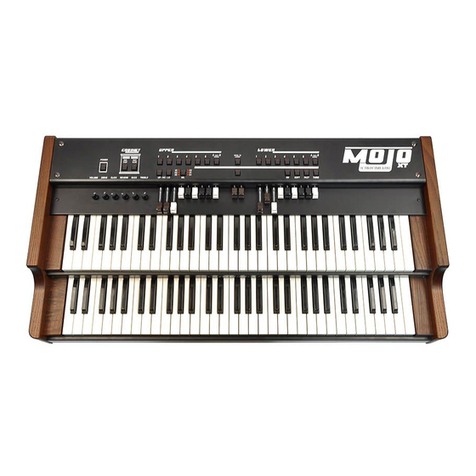
Crumar
Crumar MOJO User manual
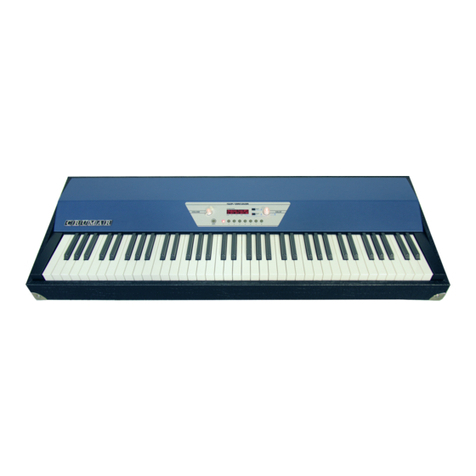
Crumar
Crumar Seventeen User manual
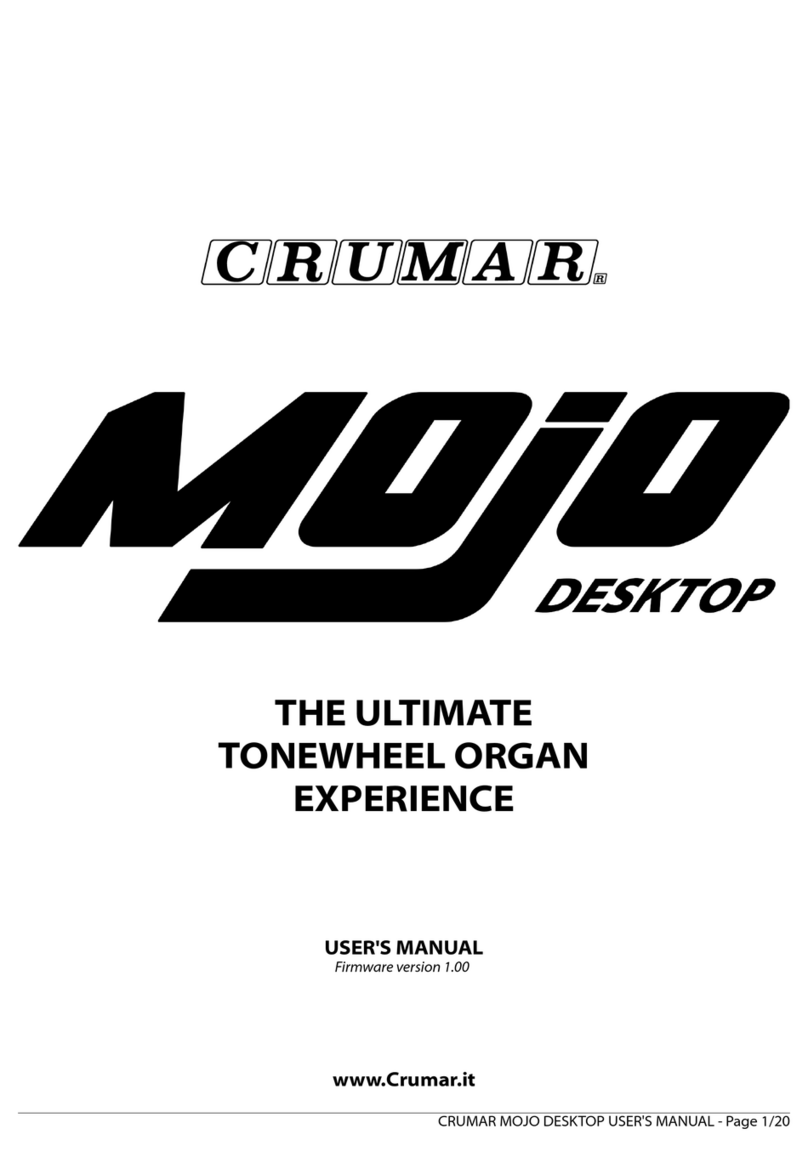
Crumar
Crumar MOJO User manual
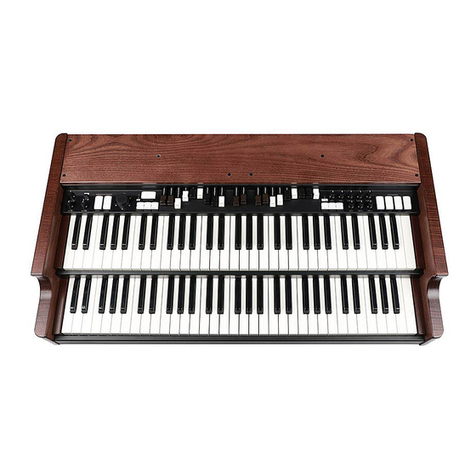
Crumar
Crumar Mojo Classic User manual

Crumar
Crumar MOJO User manual
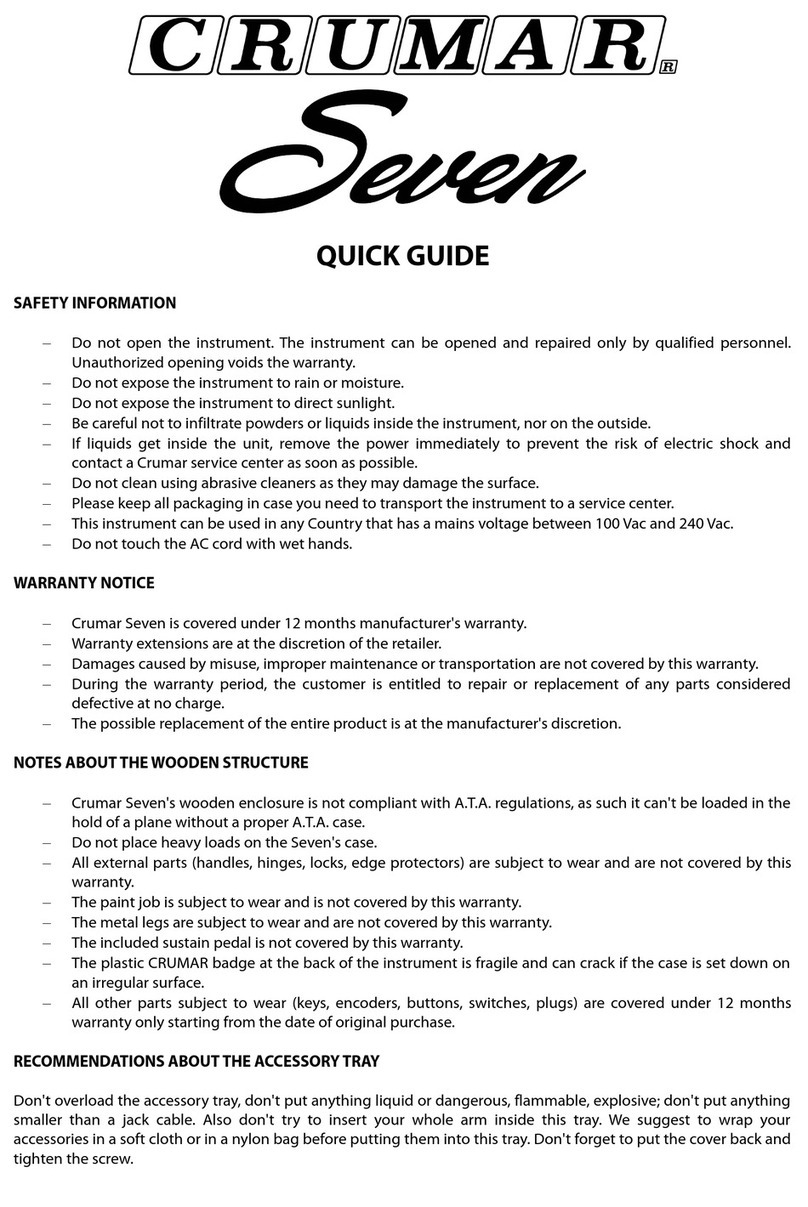
Crumar
Crumar Seven User manual
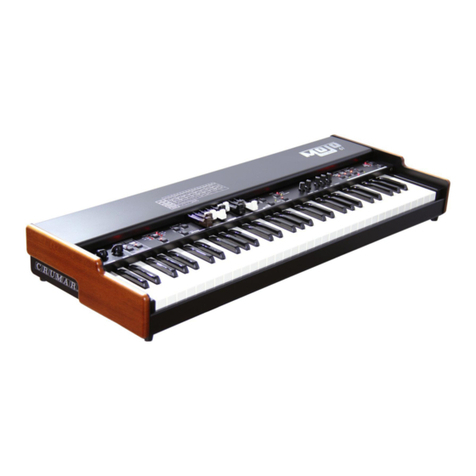
Crumar
Crumar MOJO 61 User manual

Crumar
Crumar MOJO User manual
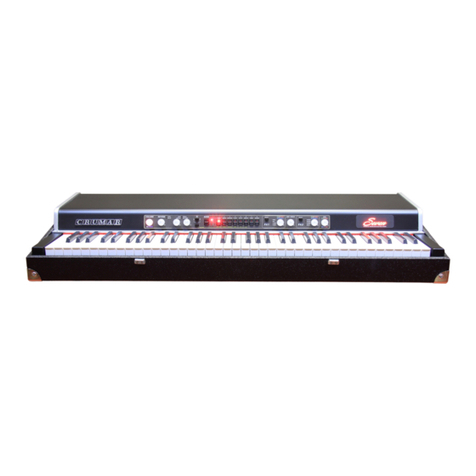
Crumar
Crumar Seven User manual

Crumar
Crumar MOJO 61 User manual
